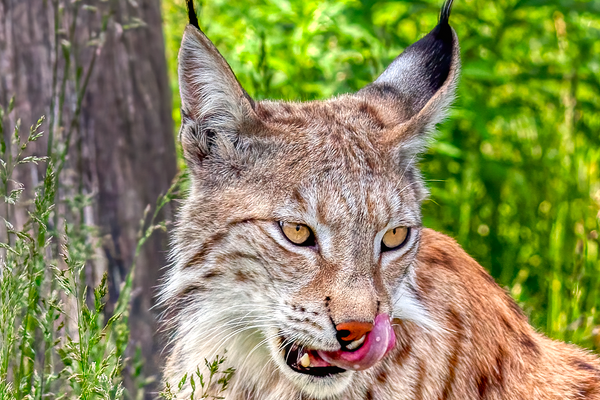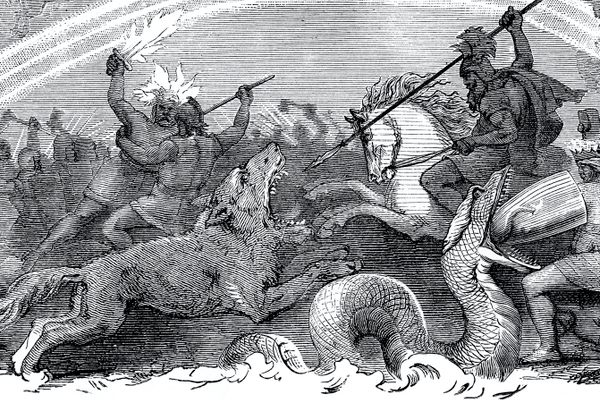Why Researchers Howl At Wolves—And Why Some Might Stop
For wolf experts, “elicited howling surveys” involve fearlessly imitating what they aim to study.

When searching for their subjects out in the field, animal researchers rely on a whole bag of tricks. They might hide in hunting blinds until their species of choice comes by, or pinpoint them with satellites. They can set up nets to catch them, bait them into humane traps, or use automatic cameras to figure out whether they’ve wandered through.
Wolf experts, though, have a different strategy. If they’re hoping to locate a pack, they don’t usually bother with waiting, or equipment. They just tilt their heads back, purse their lips, and let out a nice, long howl.
This is the gist of a technique called “elicited howling”—biologist-speak for “making noises at wolves so that they’ll howl back at you.” For decades, elicited howling has been an indispensable part of the wolf researcher’s toolkit.
“It’s standard for anyone working with wolves who wants to find out where they are,” says Dr. Dave Mech, chair of the IUCN’s Wolf Specialist Group. And despite the rise of high-tech alternatives, many expect it to reverberate long into the field’s future.

Wolves howl for a few reasons: to find stray pack members, to chat with their friends, and to tell everyone else to stay away. Because it’s such a social sound, when wolves hear a howl—or something like it—they typically respond in kind. They’re also not very picky: “Wolves will reply to fire sirens, to train whistles, any number of things,” says Mech. Scientists can then use those replies to figure out where the pack hangs out, approximately how big it is, and whether there are any pups, which have slightly squeakier howls.
Rigorous elicited howling began in 1959, when a biologist named Doug Pimlott brought a recording of wolf sounds and a playback device with him into the field. Pimlott drove the equipment to various spots in Ontario in order to survey different populations.
For a few years afterward, this method was de rigueur: “I had a battery-operated vinyl disc player that I hauled around with me in a backpack,” Mech remembers. “In various places, I would just play the record of wolves howling, and try to get replies.” But this was a cumbersome way to do work—and so Mech evolved. “Eventually, I learned to just do the howling myself,” he says.
These days, despite the prevalence of radio tracking, GPS, and other high-tech methods, plain old howling is still standard practice for wolf biologists. “In an area where you’re starting out and you don’t know where the wolves are—or even if there are any there—just about everyone knows that one way to find them is to do this howling,” says Mech. Over the course of a long study in 1979, he and his research partner, Fred Harrington, howled a combined 7,600 times. The best practices they laid out after this experience—stick to dusk or nighttime; alternate “flat” and “breaking” styles; wait two minutes between howls—are still cited today.
Despite these prescriptions, Mech insists the process is intuitive. “Most people learn right away,” he says. “You just imitate what you hear.” In Youtube videos, experts like Wisconsin’s Adrian Wydeven and Sarah Boles demonstrate their howls—some barky, some keening, some loud and some quiet, to cover all their bases. They claim about a five percent response rate. If you want to practice with some real wolves, Mech’s original study site, Algonquin Provincial Park, has held weekly howls for the public every August since 1963 (no dogs allowed).
Some researchers, though, are moving away from this technique. In a recent article in Bioacoustics, a group of European wolf experts details the merits of “non-invasive acoustic detection”—a less active strategy, which involves leaving sound recorders out and waiting for the wolves to howl on their own.

“Wolf surveying is a difficult and often expensive task” when undertaken solely by people, writes the article’s lead author Stefan Suter, of the Zurich University of Applied Sciences. When he and his team used passive recording devices—and ran the results through a spectrogram, so as to look at them visually—the howl detection process was 72 times faster than if they had done the howling themselves.
Non-native howlers can also stress out the wolves, who will assume someone has invaded their territory, says Suter. Their human neighbors may not take it so well, either. Suter enjoys howling—“I get emotionally touched when I hear a wolf,” he says—and says that doing it himself gives him a “keen sense” about the creatures he’s studying. But he thinks the new tools are crucial, especially in places like the Swiss Alps, where the wolves’ recent return is causing problems for sheep herders.
Mech sees the pros and cons. “With a passive system, you don’t have to be out there all the time—and sure, that’s an advantage,” he says. But it also doesn’t account for the fickleness of the particular lupine subject. “Wolves don’t howl just when you want them to,” Mech insists. Only humans do that.
Naturecultures is a weekly column that explores the changing relationships between humanity and wilder things. Have something you want covered (or uncovered)? Send tips to [email protected].
Update, 1/3: The original version of this article said that Suter et. al’s howl detection process is 18 times faster than previous methods—it is actually 72 times faster.









Follow us on Twitter to get the latest on the world's hidden wonders.
Like us on Facebook to get the latest on the world's hidden wonders.
Follow us on Twitter Like us on Facebook